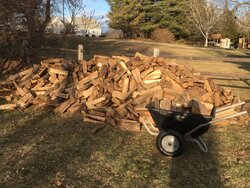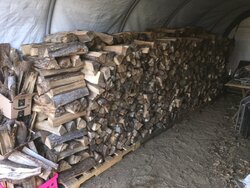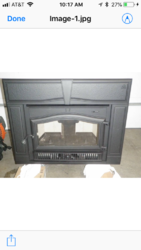I've been reading the heck out of this forum for 4-6 weeks now. I've decided on a wood insert for my existing fireplace. (37W x 26.75H x 30D) I'm having my 25ft chimney repointed at top, new cap and 6" insulated Stainless flue installed. It's a end of house, exterior chimney. We are in a 70's split with all new windows and "fair" insulation, but about to have my entryway (the one trouble spot) re-insulated with blown in wall and over head. should make a big difference as the stairs leading to the main living room are right off the entryway. The living room is 25' x 15' and is where the insert will be and where we spend the bulk of our time. upstairs is the kitchen and bedrooms with 1 of the 2 bathrooms and we like to sleep fairly cool, so our heat needs are primarily for downstairs only. We heat with oil, so like most folks it seems we are looking to save on oil by holding off on cranking up the thermostat and heating the entire downstairs ( 2 other BR's and a utility room) when we are just sitting in the LR. Concerns: don't want to blow ourselves out of the LR with a ton of heat. We sit about 5-12 ft from the insert location. We had a VC Intrepid in our old 25x50ft 3 bdrm ranch and we'd have to sometimes crack windows to offset the woodstove. Don't really care about a blower. 1) we are sitting right nearby, don't want the heat blowing on us. 2) although we are set up with a Gen if power goes out, I only like to run it occasionally to use appliances, pull water from the well, heat the water etc. I'd like a decent enough insert to keep the downstairs warm during a outage, and hopefully the upstairs about 50-55.
Number 1 contender is the Lopi 1750i Republic. Major attractions are 2.2 cf Box, sticks out about 10" for more (perceived?) radiant heat, I like the flue damper for quick starts and smokless restocking and of course a good name brand. Most feedback is positive, but some on here note "hard to start"? "Not happy with heat output" , "burns wood too fast". I'm thinking/hoping wood quality comes into play here as most folks love it. I've read independent review articles that sing its praises. Cost for me, stove only, $2100 without the blower. Can add it later for $400 I was told.
Others being considered are SBI Century 2900 at $1400 bigger box at 2.4cf, takes a 20" log vs 18. But 3.9g/h particulate vs Lopi's 1.9g/h. Does this effect burning, or ash build up, or is it a "emissions" issue only?
Drolet 1800 at $2200. Same specs as the Century (Both SBI) however only 1.54g/h particulate. Much less then the Century!
Timberwolf EPI22 at $1800, same 18" log as the Lopi, but a slightly smaller box at 1.9cf.
Before I pull the trigger on the Lopi, just want to be sure I'm considering all. The $1400 Century with a larger box is tempting me, but I'm always happy to spend more for a quality product if there is a true benefit.
Sorry for the LONG post, but I know others have been asked a lot of these questions by members after they post a question. BTW, I just received and stacked 2 cord of 2 yr seasoned hardwood and anticipate burning 1 to 1.5 cord per yr. Thank you!
Number 1 contender is the Lopi 1750i Republic. Major attractions are 2.2 cf Box, sticks out about 10" for more (perceived?) radiant heat, I like the flue damper for quick starts and smokless restocking and of course a good name brand. Most feedback is positive, but some on here note "hard to start"? "Not happy with heat output" , "burns wood too fast". I'm thinking/hoping wood quality comes into play here as most folks love it. I've read independent review articles that sing its praises. Cost for me, stove only, $2100 without the blower. Can add it later for $400 I was told.
Others being considered are SBI Century 2900 at $1400 bigger box at 2.4cf, takes a 20" log vs 18. But 3.9g/h particulate vs Lopi's 1.9g/h. Does this effect burning, or ash build up, or is it a "emissions" issue only?
Drolet 1800 at $2200. Same specs as the Century (Both SBI) however only 1.54g/h particulate. Much less then the Century!
Timberwolf EPI22 at $1800, same 18" log as the Lopi, but a slightly smaller box at 1.9cf.
Before I pull the trigger on the Lopi, just want to be sure I'm considering all. The $1400 Century with a larger box is tempting me, but I'm always happy to spend more for a quality product if there is a true benefit.
Sorry for the LONG post, but I know others have been asked a lot of these questions by members after they post a question. BTW, I just received and stacked 2 cord of 2 yr seasoned hardwood and anticipate burning 1 to 1.5 cord per yr. Thank you!
Last edited:




